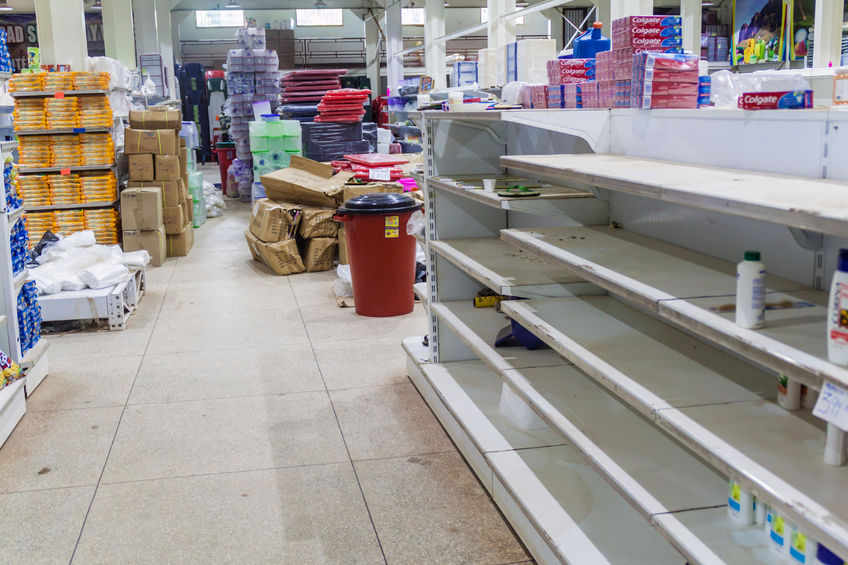The shelves above were emptied by Venezuelan Socialism, not CO2
A lead May 14 article posted by Sonya Collins in WebMD, “Will Climate Change Cause Food Sources to Dwindle?” suffers from very poor planet, plant and people health diagnostics.
Key claims of the medically-muddled meme are that human carbon dioxide emissions are causing more frequent severe weather conditions to occur (which isn’t happening); that warmer temperatures will somehow inhibit agricultural production (which is totally bewildering); and that increased atmospheric CO2 levels are detrimental to plant growth (which is entirely nonsensical).
Oh, I nearly forgot to mention that a “years-long drought” attributed to all of the above “was among the many things that sparked the civil war [in Syria] that began in 2011.”
It wasn’t noted anywhere that droughts have been the normal features of arid desert life in Syria and neighboring regions over thousands of years before carbonated fossil fuels largely replaced use of presumably climate-ravaging methane-enriched camel dung.
Actually, according to United Nations Food and Agriculture Organization data, Syrian crop production has witnesses an approximate 50 percent increase since 1995. The Arab Spring democracy uprisings in Syria and elsewhere occurred in 2011, a year when Syria produced its eighth highest crop yields in history.
As for those recent “record-breaking . . . heat waves, droughts, wild fires, and floods that have become the norm in recent years [which] have serious implications for the food supply,” this “norm” has always been entirely normal. Even NOAA and the reliably alarmist IPCC have admitted that there have been no global increases in either the severities or frequencies of droughts, floods, thunderstorms, nor tornadoes in decades.
Collins attempts to make a case that “warmer winters cause premature budding that leads to crop loss.”
If so, there certainly isn’t any observable evidence of this.
World-Grain.com reported that 2016 world cereal production had broken records for the third straight year.
Heartland Institute’s senior fellow for environment, James Taylor, observes that crop yields are now setting some records in developing countries where food supplies are typically most scarce.
Rice and coarse cereal production set new highs in India (2017 through 2018), and in Bangladesh (2016). Honduras has set recent yearly records for its production of staple and commercial a crops, including maize, rice, wheat, and coffee.
Here at home, FarmWeekNow reported in September 2018, that USDA predictions that America’s corn yield will establish a new record of 181.3 bushels per acre, up 4.7 bushels per acre from 2017. This estimated 14,827 billion bushels would also represent the second-largest amount on record behind the 15.1 bushels grown in 2016.
USDA’s 2018 soybean estimates also reached record levels of 4.69 billion bushels nationwide. The soybean yield reached a new 52.8 bushels per acre record too, up 3.7 bushels from last year.
Even though warming temperatures measured by satellites over the past couple of decades range between statistically negligible to none, Collins still makes a strange climate risk argument that “warmer winters cause premature budding that leads to crop loss.”
Well, what about also giving some credit to the longer growing seasons for plants as well? Like, for example, the enablement of farmers to harvest two crops on the same amount of land during a growing season?
Collin’s most distorted contortion of credulity suggests that increased atmospheric CO2 levels present a plant growth liability.
A study published in the journal Nature Climate Change by an international team of researchers representing 24 institutions in eight countries found, “From a quarter to half of Earth’s vegetated lands has shown significant greening over the last 35 years largely due to rising levels of atmospheric carbon dioxide.”
CO2 is fundamentally vital to the survival, health and growth of all forests, grasslands, gardens, and other areas of leafy plants. Increased CO2 levels are — by any measure, a very good thing.
Adding more CO2 increases the rate of a plant’s photosynthesis, improves its water-retaining efficiency, and improves its natural pest resistance.
Atmospheric CO2 enrichment causes plants to sequentially reduce the openness of their stomata to restrict water loss via excessive transpiration, a particularly important benefit for desert plants. More CO2 also enhances plant growth and the ultimate yields of agricultural crops by increasing concentrations of hormones that stimulate cell division, cell elongation, and protein synthesis.
Plentiful CO2 significantly enhances condensed tannin concentrations of most trees and grasses to strengthen defenses against herbivores above and below ground, produces natural substances that reduce the frequency and severity of herbivory against food crops, and makes more naturally fertilizing nitrogen available by stimulating microbial decomposition in the soil.
WebMD writer Sonya Collins would do well to consider that energy and food abundance made possible through fossil fuels and their CO2 emissions continues to raise billions of the world’s population out of extreme poverty and hunger which represent true health risks.
Any contrary diagnoses of these very fortunate realities warrant a second medical opinion.
